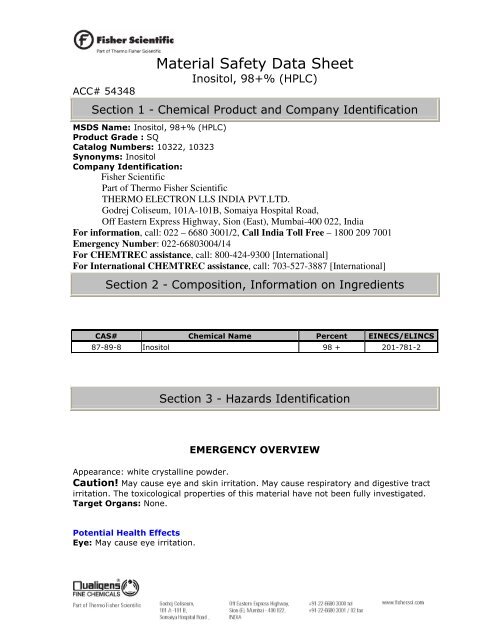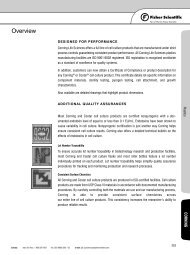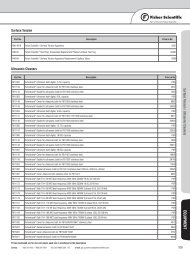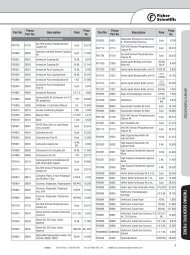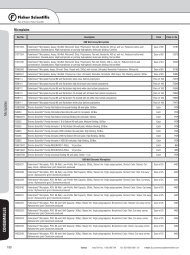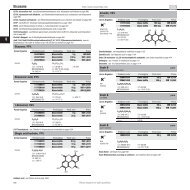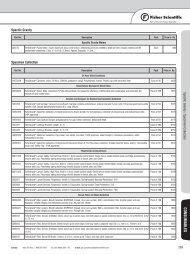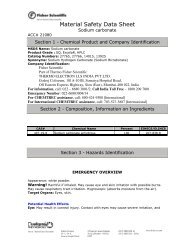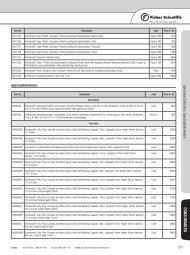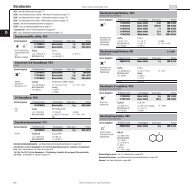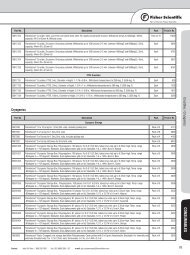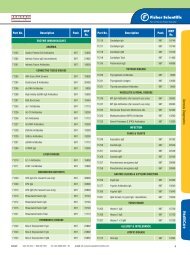Material Safety Data Sheet - Fisher Scientific: Lab Equipment
Material Safety Data Sheet - Fisher Scientific: Lab Equipment
Material Safety Data Sheet - Fisher Scientific: Lab Equipment
Create successful ePaper yourself
Turn your PDF publications into a flip-book with our unique Google optimized e-Paper software.
ACC# 54348<br />
<strong>Material</strong> <strong>Safety</strong> <strong>Data</strong> <strong>Sheet</strong><br />
Inositol, 98+% (HPLC)<br />
Section 1 - Chemical Product and Company Identification<br />
MSDS Name: Inositol, 98+% (HPLC)<br />
Product Grade : SQ<br />
Catalog Numbers: 10322, 10323<br />
Synonyms: Inositol<br />
Company Identification:<br />
<strong>Fisher</strong> <strong>Scientific</strong><br />
Part of Thermo <strong>Fisher</strong> <strong>Scientific</strong><br />
THERMO ELECTRON LLS INDIA PVT.LTD.<br />
Godrej Coliseum, 101A-101B, Somaiya Hospital Road,<br />
Off Eastern Express Highway, Sion (East), Mumbai-400 022, India<br />
For information, call: 022 – 6680 3001/2, Call India Toll Free – 1800 209 7001<br />
Emergency Number: 022-66803004/14<br />
For CHEMTREC assistance, call: 800-424-9300 [International]<br />
For International CHEMTREC assistance, call: 703-527-3887 [International]<br />
Section 2 - Composition, Information on Ingredients<br />
CAS# Chemical Name Percent EINECS/ELINCS<br />
87-89-8 Inositol 98 + 201-781-2<br />
Section 3 - Hazards Identification<br />
EMERGENCY OVERVIEW<br />
Appearance: white crystalline powder.<br />
Caution! May cause eye and skin irritation. May cause respiratory and digestive tract<br />
irritation. The toxicological properties of this material have not been fully investigated.<br />
Target Organs: None.<br />
Potential Health Effects<br />
Eye: May cause eye irritation.
Skin: May cause skin irritation.<br />
Ingestion: May cause irritation of the digestive tract. The toxicological properties of this<br />
substance have not been fully investigated.<br />
Inhalation: May cause respiratory tract irritation. The toxicological properties of this<br />
substance have not been fully investigated.<br />
Chronic: No information found.<br />
Section 4 - First Aid Measures<br />
Eyes: Flush eyes with plenty of water for at least 15 minutes, occasionally lifting the<br />
upper and lower eyelids. Get medical aid.<br />
Skin: Get medical aid. Flush skin with plenty of water for at least 15 minutes while<br />
removing contaminated clothing and shoes. Wash clothing before reuse.<br />
Ingestion: Never give anything by mouth to an unconscious person. Get medical aid.<br />
Do NOT induce vomiting. If conscious and alert, rinse mouth and drink 2-4 cupfuls of<br />
milk or water.<br />
Inhalation: Remove from exposure and move to fresh air immediately. If not<br />
breathing, give artificial respiration. If breathing is difficult, give oxygen. Get medical<br />
aid.<br />
Notes to Physician: Treat symptomatically and supportively.<br />
Section 5 - Fire Fighting Measures<br />
General Information: As in any fire, wear a self-contained breathing apparatus in<br />
pressure-demand, MSHA/NIOSH (approved or equivalent), and full protective gear.<br />
During a fire, irritating and highly toxic gases may be generated by thermal<br />
decomposition or combustion.<br />
Extinguishing Media: Use agent most appropriate to extinguish fire. Use water spray,<br />
dry chemical, carbon dioxide, or appropriate foam.<br />
Flash Point: Not applicable.<br />
Autoignition Temperature: Not applicable.<br />
Explosion Limits, Lower:Not available.<br />
Upper: Not available.<br />
NFPA Rating: (estimated) Health: 1; Flammability: 0; Instability: 0<br />
Section 6 - Accidental Release Measures<br />
General Information: Use proper personal protective equipment as indicated in
Section 8.<br />
Spills/Leaks: Vacuum or sweep up material and place into a suitable disposal<br />
container. Clean up spills immediately, observing precautions in the Protective<br />
<strong>Equipment</strong> section. Avoid generating dusty conditions. Provide ventilation.<br />
Section 7 - Handling and Storage<br />
Handling: Wash thoroughly after handling. Wash hands before eating. Remove<br />
contaminated clothing and wash before reuse. Use with adequate ventilation. Minimize<br />
dust generation and accumulation. Avoid contact with eyes, skin, and clothing. Keep<br />
container tightly closed. Avoid ingestion and inhalation.<br />
Storage: Keep container closed when not in use. Store in a tightly closed container.<br />
Store in a cool, dry, well-ventilated area away from incompatible substances.<br />
Section 8 - Exposure Controls, Personal Protection<br />
Engineering Controls: Facilities storing or utilizing this material should be equipped<br />
with an eyewash facility and a safety shower. Use adequate ventilation to keep airborne<br />
concentrations low.<br />
Exposure Limits<br />
Chemical Name ACGIH NIOSH OSHA - Final PELs<br />
Inositol none listed none listed none listed<br />
OSHA Vacated PELs: Inositol: No OSHA Vacated PELs are listed for this chemical.<br />
Personal Protective <strong>Equipment</strong><br />
Eyes: Wear appropriate protective eyeglasses or chemical safety goggles as described<br />
by OSHA's eye and face protection regulations in 29 CFR 1910.133 or European<br />
Standard EN166.<br />
Skin: Wear appropriate protective gloves to prevent skin exposure.<br />
Clothing: Wear appropriate protective clothing to prevent skin exposure.<br />
Respirators: A respiratory protection program that meets OSHA's 29 CFR 1910.134 and<br />
ANSI Z88.2 requirements or European Standard EN 149 must be followed whenever<br />
workplace conditions warrant respirator use.<br />
Section 9 - Physical and Chemical Properties
Physical State: Crystalline powder<br />
Appearance: white<br />
Odor: none reported<br />
pH: Not available.<br />
Vapor Pressure: Not available.<br />
Vapor Density: 6.2<br />
Evaporation Rate:Not available.<br />
Viscosity: Not available.<br />
Boiling Point: Not available.<br />
Freezing/Melting Point:224 - 225 deg C<br />
Decomposition Temperature:Not available.<br />
Solubility: Soluble in water.<br />
Specific Gravity/Density:1.752<br />
Molecular Formula:C6H12O6<br />
Molecular Weight:180.0804<br />
Section 10 - Stability and Reactivity<br />
Chemical Stability: Stable under normal temperatures and pressures.<br />
Conditions to Avoid: Incompatible materials, dust generation, excess heat, strong<br />
oxidants.<br />
Incompatibilities with Other <strong>Material</strong>s: Strong oxidizing agents.<br />
Hazardous Decomposition Products: Carbon monoxide, irritating and toxic fumes<br />
and gases, carbon dioxide.<br />
Hazardous Polymerization: Has not been reported.<br />
Section 11 - Toxicological Information<br />
RTECS#:<br />
CAS# 87-89-8: NM7520800<br />
LD50/LC50:<br />
CAS# 87-89-8:<br />
Oral, mouse: LD50 = 10 gm/kg;<br />
.<br />
Intraperitoneal, rat: LD50 = > 3gm/kg.; Intravenous, rat: LD50 > 750 mg/kg.; Oral,<br />
mouse: LD50 = 10<br />
Carcinogenicity:<br />
CAS# 87-89-8: Not listed by ACGIH, IARC, NTP, or CA Prop 65.<br />
Epidemiology: No information available.
Teratogenicity: No information available.<br />
Reproductive Effects: No information available.<br />
Mutagenicity: No information available.<br />
Neurotoxicity: No information available.<br />
Other Studies:<br />
No information available.<br />
Section 12 - Ecological Information<br />
Section 13 - Disposal Considerations<br />
Chemical waste generators must determine whether a discarded chemical is classified as<br />
a hazardous waste. US EPA guidelines for the classification determination are listed in 40<br />
CFR Parts 261.3. Additionally, waste generators must consult state and local hazardous<br />
waste regulations to ensure complete and accurate classification.<br />
RCRA P-Series: None listed.<br />
RCRA U-Series: None listed.<br />
Section 14 - Transport Information<br />
US DOT Canada TDG<br />
Shipping Name: Not regulated as a hazardous material No information available.<br />
Hazard Class:<br />
UN Number:<br />
Packing Group:<br />
US FEDERAL<br />
Section 15 - Regulatory Information<br />
TSCA<br />
CAS# 87-89-8 is listed on the TSCA inventory.<br />
Health & <strong>Safety</strong> Reporting List
None of the chemicals are on the Health & <strong>Safety</strong> Reporting List.<br />
Chemical Test Rules<br />
None of the chemicals in this product are under a Chemical Test Rule.<br />
Section 12b<br />
None of the chemicals are listed under TSCA Section 12b.<br />
TSCA Significant New Use Rule<br />
None of the chemicals in this material have a SNUR under TSCA.<br />
CERCLA Hazardous Substances and corresponding RQs<br />
None of the chemicals in this material have an RQ.<br />
SARA Section 302 Extremely Hazardous Substances<br />
None of the chemicals in this product have a TPQ.<br />
Section 313 No chemicals are reportable under Section 313.<br />
Clean Air Act:<br />
This material does not contain any hazardous air pollutants.<br />
This material does not contain any Class 1 Ozone depletors.<br />
This material does not contain any Class 2 Ozone depletors.<br />
Clean Water Act:<br />
None of the chemicals in this product are listed as Hazardous Substances under the<br />
CWA.<br />
None of the chemicals in this product are listed as Priority Pollutants under the CWA.<br />
None of the chemicals in this product are listed as Toxic Pollutants under the CWA.<br />
OSHA:<br />
None of the chemicals in this product are considered highly hazardous by OSHA.<br />
STATE<br />
CAS# 87-89-8 is not present on state lists from CA, PA, MN, MA, FL, or NJ.<br />
California Prop 65<br />
California No Significant Risk Level: None of the chemicals in this product are listed.<br />
European/International Regulations<br />
European <strong>Lab</strong>eling in Accordance with EC Directives<br />
Hazard Symbols:<br />
Not available.<br />
Risk Phrases:<br />
<strong>Safety</strong> Phrases:<br />
S 24/25 Avoid contact with skin and eyes.<br />
S 37 Wear suitable gloves.<br />
S 45 In case of accident or if you feel unwell, seek medical advice<br />
immediately (show the label where possible).<br />
S 28A After contact with skin, wash immediately with plenty of water<br />
.<br />
WGK (Water Danger/Protection)<br />
CAS# 87-89-8: No information available.<br />
Canada - DSL/NDSL<br />
CAS# 87-89-8 is listed on Canada's DSL List.<br />
Canada - WHMIS<br />
This product has a WHMIS classification of Not controlled..
This product has been classified in accordance with the hazard criteria of the Controlled<br />
Products Regulations and the MSDS contains all of the information required by those<br />
regulations.<br />
Canadian Ingredient Disclosure List<br />
MSDS Creation Date: 3/08/1999<br />
Revision #3 Date: 10/03/2005<br />
Section 16 - Additional Information<br />
The information above is believed to be accurate and represents the best information currently available to us.<br />
However, we make no warranty of merchantability or any other warranty, express or implied, with respect to such<br />
information, and we assume no liability resulting from its use. Users should make their own investigations to<br />
determine the suitability of the information for their particular purposes. In no event shall <strong>Fisher</strong> be liable for any<br />
claims, losses, or damages of any third party or for lost profits or any special, indirect, incidental, consequential or<br />
exemplary damages, howsoever arising, even if <strong>Fisher</strong> has been advised of the possibility of such damages.


